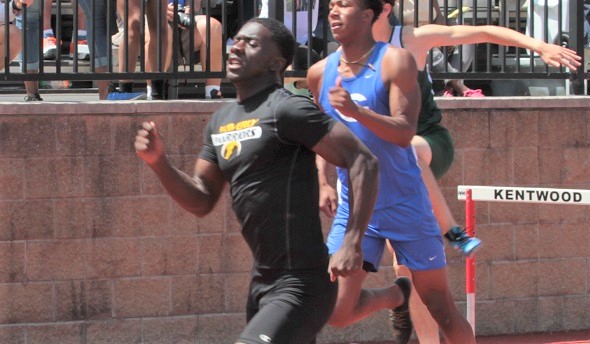
Performance: Waverly's Keshaun Harris
May 24, 2019
 Keshaun Harris
Keshaun Harris
Lansing Waverly senior – Track & Field
The reigning Lower Peninsula Division 1 champion in the 300-meter hurdles, Harris put himself in position to challenge for multiple titles at next weekend’s MHSAA Finals with wins in both the 300 (38.71 seconds) and 110 (14.23) at last week’s Regional at East Lansing, earning him the Michigan Army National Guard “Performance of the Week.”
Harris’ winning 300 time was his season best, as was his 14.14 prelim time in the 110. Also an all-league football player during the fall and starting guard in basketball, Harris is among the state’s elite on the track and undefeated in both hurdles races this spring despite getting a slow start after hurting his right ankle in his final basketball game this winter. As noted, he won the LPD1 title in the 300 last season in a personal-record 37.81 seconds and just missed the double finishing seventh hundredths of a second behind East Kentwood’s Job Mayhue in the 110. Harris also finished second in the 110 and third in the 300 at the LPD2 Finals as a sophomore, and qualified for the LPD2 Finals in both races as a freshman, earning seventh place in the 110.
 The 37.81 at last year’s Finals and the 14 flat he ran in the 110 at the 2018 Regional are Waverly school records – which says a lot as the Warriors have produced a number of state contenders over coach David Pike’s 29 seasons leading one of mid-Michigan’s strongest programs. Harris will announce next week where he’ll continue his academic and athletic careers at the collegiate level – he has Division I and II opportunities – and will bring both first-class hurdling skills and a 3.6 GPA with aspirations of studying kinesiology and becoming an athletic trainer.
The 37.81 at last year’s Finals and the 14 flat he ran in the 110 at the 2018 Regional are Waverly school records – which says a lot as the Warriors have produced a number of state contenders over coach David Pike’s 29 seasons leading one of mid-Michigan’s strongest programs. Harris will announce next week where he’ll continue his academic and athletic careers at the collegiate level – he has Division I and II opportunities – and will bring both first-class hurdling skills and a 3.6 GPA with aspirations of studying kinesiology and becoming an athletic trainer.
Coach David Pike said: “Keshaun’s success in the hurdles is due to his focus on getting better every day. He’s always the last one off the track, taking time each day to get the repetitions he needs to become fluent with each motion. The quickness and fluidity of his hurdling action come from years of focused practice. That’s not to say he’s hurdling 365 days a year. In fact, much of his success in track and field comes from his involvement in other sports. Football has helped him develop the strength and toughness needed to run through hurdle contact. Basketball with all of its jumping and rapid changes of direction has helped him become a more explosive and kinesthetically aware athlete. In the end, the bottom line is that Keshaun’s dedication to daily incremental improvement as an athlete has put him in position to compete for the state title in both the high and 300 hurdles.”
Performance Point: “Nobody really knew this but my coach, but I was sick,” Harris said in recalling the Regional. “I was pushing through it, so I just went out there and ran my best races of the season. I was dealing with the flu. .... Before the race I had to hydrate a lot. My body was a little weak. I had to make sure I got my body moving, got in a good warm-up, stayed loose and warm. I just went out there and gave it everything I’ve got and ran my best.”
Remembering runner-up: “(Last year’s 110 Final) has been in the back of my mind since it happened last year. My goal is still to be the state champion in both the 110 and 300. That’s been the goal since I came to Waverly, since I’ve been a freshman. That’s always been the goal, and always been a motivation too. … Last year I wasn’t as good with my form as I am this year. So this year as I go into this last week, I’m just working on form, getting over hurdles and getting back down quick and keeping everything tight.”
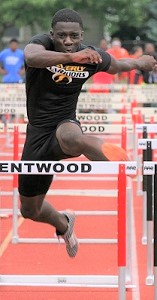 Multi-sport mechanics: “I think (all my sports) work together, because I’m always active doing something. Even in the winter or the summer, I’m always doing something. When track season comes around, I’m already in shape, and I’m already feeling good and strong. (Track has) made me even faster on the court or the field. I’m very elusive. I’m very flexible. So it’s helped me in a lot of areas.”
Multi-sport mechanics: “I think (all my sports) work together, because I’m always active doing something. Even in the winter or the summer, I’m always doing something. When track season comes around, I’m already in shape, and I’m already feeling good and strong. (Track has) made me even faster on the court or the field. I’m very elusive. I’m very flexible. So it’s helped me in a lot of areas.”
Looking up, looking ahead: “Aries Merritt, he’s an Olympic champion, and Grant Holloway goes to Florida and he’s another guy I look up to. I also look up to guys I ran against – Kentre Patterson (East Lansing), Noah Caudy (Lake Odessa Lakewood), even Job Mayhue who beat me last year. I still look up to all those guys, figure out what they’re doing and how I can input it into my hurdling. In track, you run against these guys so much. Once they’re gone, you’ve built a relationship with them, so it’s cool.”
Staying in sports: “I just like working with athletes and just being around sports, so I think (trainer) would be the perfect job to do. Actually, at the start of this season I had an ankle injury, I sprained it during my last basketball game, and that had me out for a month. As I worked with the athletic trainer at my school, I developed a love for wanting to become an athletic trainer and wanting to study kinesiology.”
- Geoff Kimmerly, Second Half editor
Every week during the 2018-19 school year, Second Half and the Michigan Army National Guard recognizes a “Performance of the Week" from among the MHSAA's 750 member high schools.
The Michigan Army National Guard provides trained and ready forces in support of the National Military Strategy, and responds as needed to state, local, and regional emergencies to ensure peace, order, and public safety. The Guard adds value to our communities through continuous interaction. National Guard soldiers are part of the local community. Guardsmen typically train one weekend per month and two weeks in the summer. This training maintains readiness when needed, be it either to defend our nation's freedom or protect lives and property of Michigan citizens during a local natural disaster.
Past 2018-19 honorees
May 16: Gabbie Sherman, Millington softball - Read
May 9: Nathan Taylor, Muskegon Mona Shores golf - Read
May 2: Ally Gaunt, New Baltimore Anchor Bay soccer - Read
April 25: Kali Heivilin, Three Rivers softball - Read
March 28: Rickea Jackson, Detroit Edison basketball - Read
March 21: Noah Wiswary, Hudsonville Unity Christian basketball - Read
March 14: Cam Peel, Spring Lake swimming - Read
March 7: Jordan Hamdan, Hudson wrestling - Read
February 28: Kevon Davenport, Detroit Catholic Central wrestling - Read
February 21: Reagan Olli, Gaylord skiing - Read
February 14: Jake Stevenson, Traverse City Bay Reps hockey - Read
February 7: Molly Davis, Midland Dow basketball - Read
January 31: Chris DeRocher, Alpena basketball - Read
January 24: Imari Blond, Flint Kearsley bowling - Read
January 17: William Dunn, Quincy basketball - Read
November 29: Dequan Finn, Detroit Martin Luther King football - Read
November 22: Paige Briggs, Lake Orion volleyball - Read
November 15: Hunter Nowak, Morrice football - Read
November 8: Jon Dougherty, Detroit Country Day soccer - Read
November 1: Jordan Stump, Camden-Frontier volleyball - Read
October 25: Danielle Staskowski, Pontiac Notre Dame Prep golf - Read
October 18: Adam Bruce, Gladstone cross country - Read
October 11: Ericka VanderLende, Rockford cross country - Read
October 4: Kobe Clark, Schoolcraft football - Read
September 27: Jonathan Kliewer, Grand Rapids Forest Hills Northern soccer - Read
September 20: Kiera Lasky, Bronson volleyball - Read
September 13: Judy Rector, Hanover-Horton cross country - Read
PHOTOS: (Top) Lansing Waverly's Keshaun Harris charges toward the finish during last season's Lower Peninsula Division 1 Final in the 300 hurdles. (Middle) Harris clears a hurdle during the 110 championship race in 2018. (Click to see more from RunMichigan.com.)
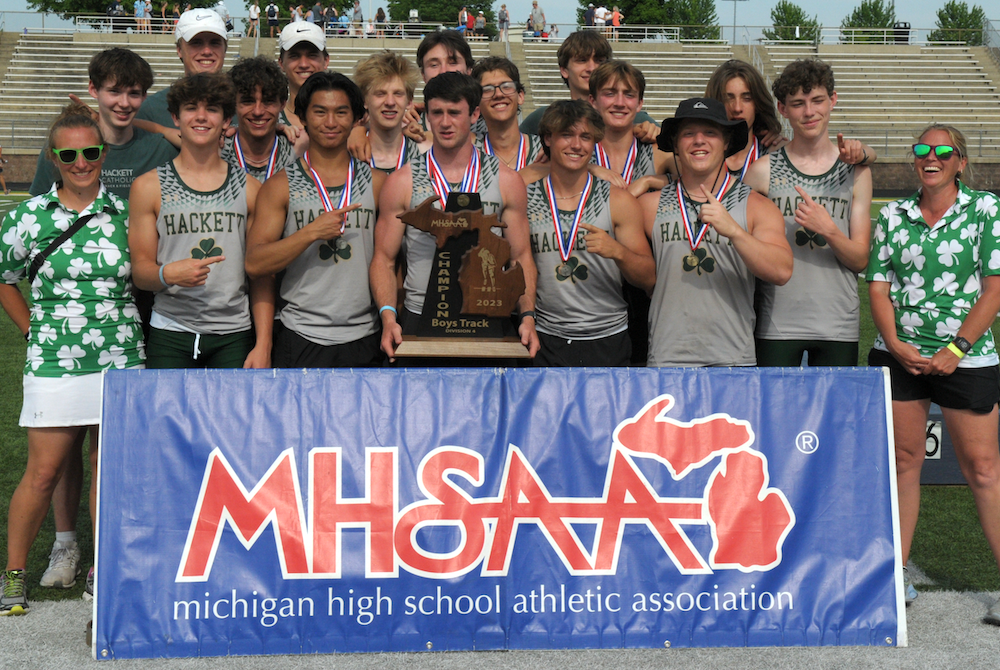
Thrower Claims Lone Individual Title to Lead Hackett to Team 3-Peat
By
Tom Lang
Special for MHSAA.com
June 3, 2023
Kalamazoo Hackett Catholic Prep just keeps winning and winning.
This time the Irish took home their fourth title in the last five Lower Peninsula Division 4 Track & Field Finals, on Saturday at Hudsonville.
Hackett’s only individual title was taken by discus winner Nathan Buchmann, a senior, who was fine knowing he was the shortest in stature among all the sizable competitors.
“In the offseason after football I worked out every day, working towards this goal,” he said after getting his medal. “I would say this takes 80 percent technique and 20 percent strength to throw the discus. So, length can help but if you have good technique and are really strong, that will play into it.
“I think we are very balanced throughout the meet today,” he said about teammates that scored points in finishes other than first place. “We have 13 guys here today, and we have people in a lot of the races. But I do not run; I have too short of legs to be a fast runner,” he said with a chuckle.
Buchmann had to work through a hip injury to compete this spring.
“I think the setbacks are what make you strong,” he said. “You can either give up through the setbacks or push forward and become better.”
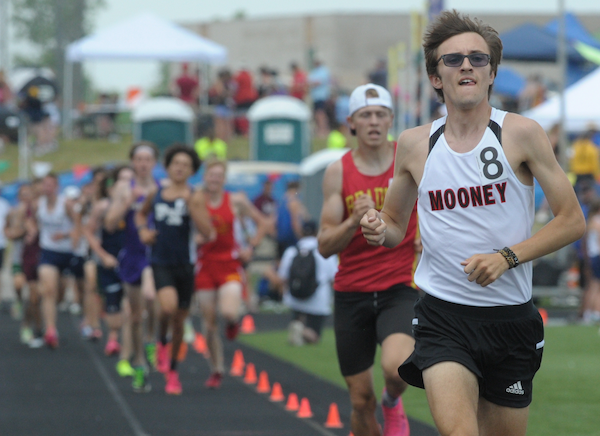 Coach Charissa Dean agreed.
Coach Charissa Dean agreed.
“The kids have big hearts,” she said after all the points were totaled and the Irish were on top once again, with 53. “They worked hard. They had a lot of potential when we started the season. And we had a lot of drive to put in the work, and we are happy the results came out the way they did.”
Reading was runner-up at 47 points, followed by Wyoming Potter’s House Christian with 42, then Fowler and Flint Beecher each with 37 points.
Senior Lezawe “Moses” Osterink, of Potter’s House Christian, placed second in 1,600 but took the 3,200 title as defending champ of both. He dominated the latter by lapping the field with a final lap kick that resembled more of a superhero speedster.
“Nobody really took it out that hard at the start,” he said. “There was a freshman (Marek Butkiewicz of Hackett) that tried to get the pace going quick, but me and Dakota (Dykhuis of Montabella) just kind of sat back and gradually pulled him through.
“We took it gradually, and I was just relying that I could kick.”
Kick did he ever. The trio were neck and neck the majority of the race in a grouping ahead of the pack.
“With 400 to go I just tried to go all out,” Osterink said. “I had a lot more left than I thought and I was pleased with the win. Not really the time, but that doesn’t matter, especially this hot out.”
The overall meet was in the low 90s/high 80s heat and searing sun all day. So, race officials allowed the unique opportunity for coaches to spray the runners with water and give them water bottles.
“It was very weird because I’ve never taken water to drink while I’m running, so I didn’t know how that would feel,” Osterink said. “And they were spraying us and hitting us in the face. It was kind of fun.”
Junior Tyler Lenn of Marine City Cardinal Mooney defeated Osterink at his own game in the 1,600.
“I’m feeling great,” Lenn said after grabbing the medal. “I said to a newspaper after one of my races (during the season) I was right where I wanted to be. This has been a long rebuilding process for me since an injury back in the fall, and I set a pretty high goal the day the injury happened. I was telling myself I needed to fulfill what I said I would do at the beginning of last cross country season. And that is what I did today.”
Lenn suffered an ankle sprain from a misstep that turned worse because he kept running through the season on it.
“Coming back from that was pretty tough, but I wouldn’t have it any other way,” he said. 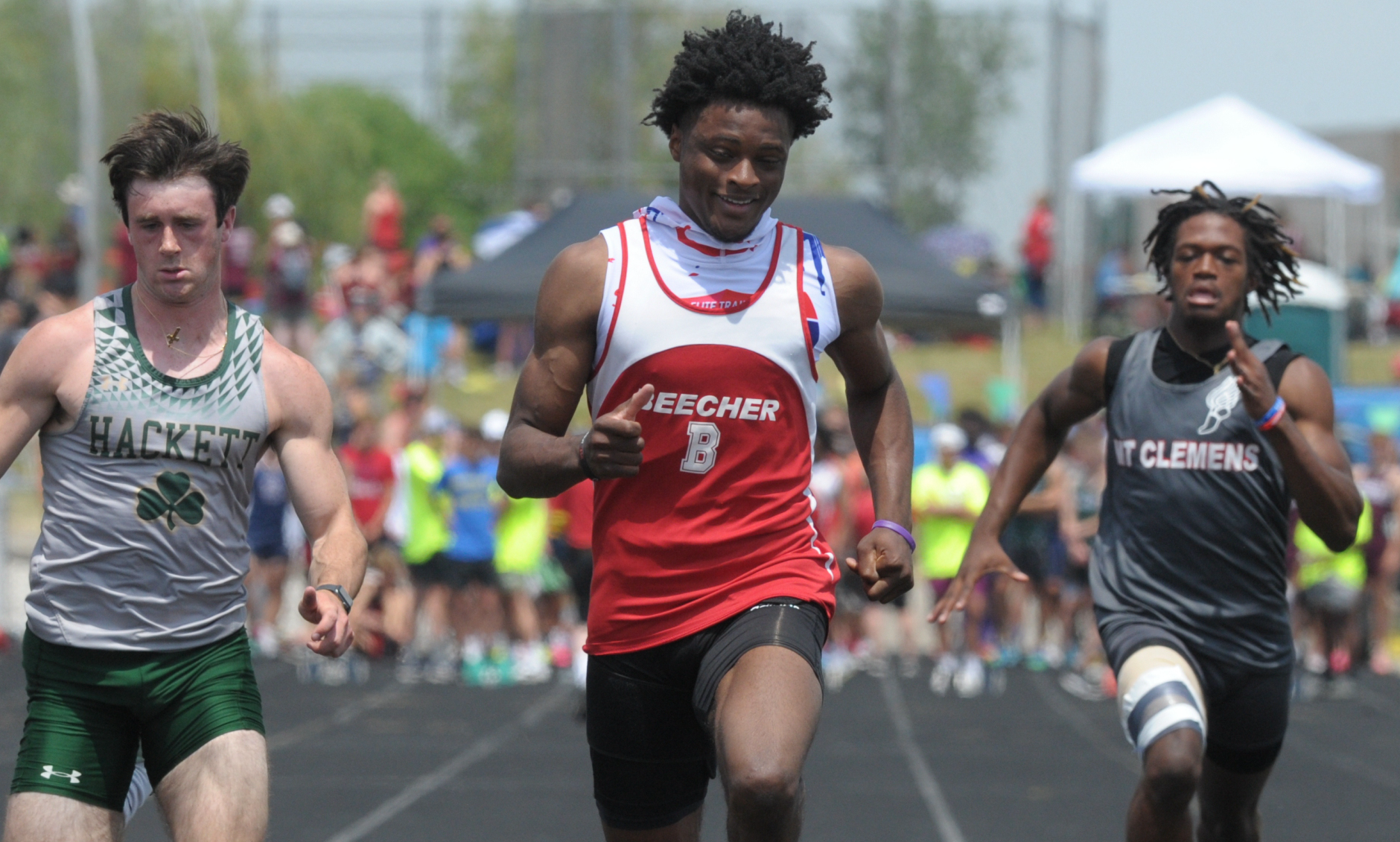 “Perseverance; I said from the beginning what I was going to do. I kept my eye on that target, and no matter the circumstances life threw at me, that I was going to make it happen and I am a man of my word.”
“Perseverance; I said from the beginning what I was going to do. I kept my eye on that target, and no matter the circumstances life threw at me, that I was going to make it happen and I am a man of my word.”
Jaylin Townsend, a senior from Flint Beecher, dominated the short races. He won the 100 dash (10.67) and 200 dash at 22 seconds flat. It was his third 100 win at a Finals.
“I put in a lot of work; I had to three-peat,” he said after the 100. “There’s a lot of great competition here, so I knew I had to come out and run my best.”
Concord in the 400 (43.72), Buckley in the 800 (1:30.76) and 1,600 (3:29.13) and Potter’s House in the 3,200 (8:14.18) were relay champs Saturday. Reading’s Tayshawn Bester won the 110 hurdles (15.13), and Athens’ Landen Bennett won the 300 (39.85). Caseville’s Nathan Feltner won the 400 (50.76), and Vestaburg’s Owen Patton claimed the 800 (1:55.11).
Fruitport Calvary Christian’s Bradley Richards won the high jump (6-10), and Peck’s Alex Affer won the long jump (23-4). McBain Northern Michigan Christian’s Isaac Bowden was first in pole vault (13-0), and Brown City’s Kyle Affer won shot put (49-2).
PHOTOS (Top) Kalamazoo Hackett Catholic Prep celebrates its third-straight LPD4 title Saturday. (Middle) Cardinal Mooney's Tyler Lenn, far right, sets the pace in the 1,600. (Below) Flint Beecher's Jaylin Townsend, middle, crosses the finish first for one of his two sprint championships. (Photos by Ken Swart/RunMichigan.com.)

